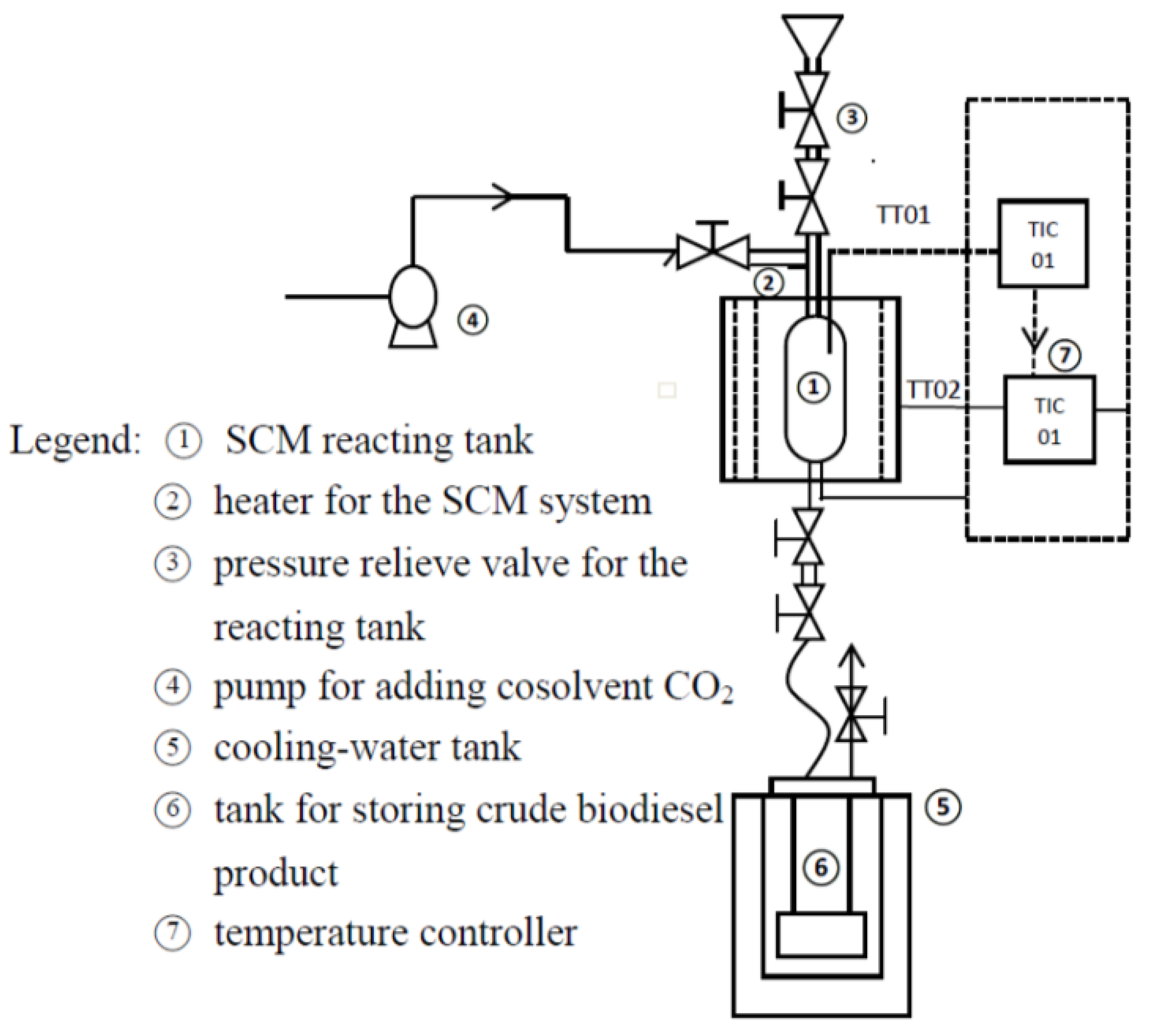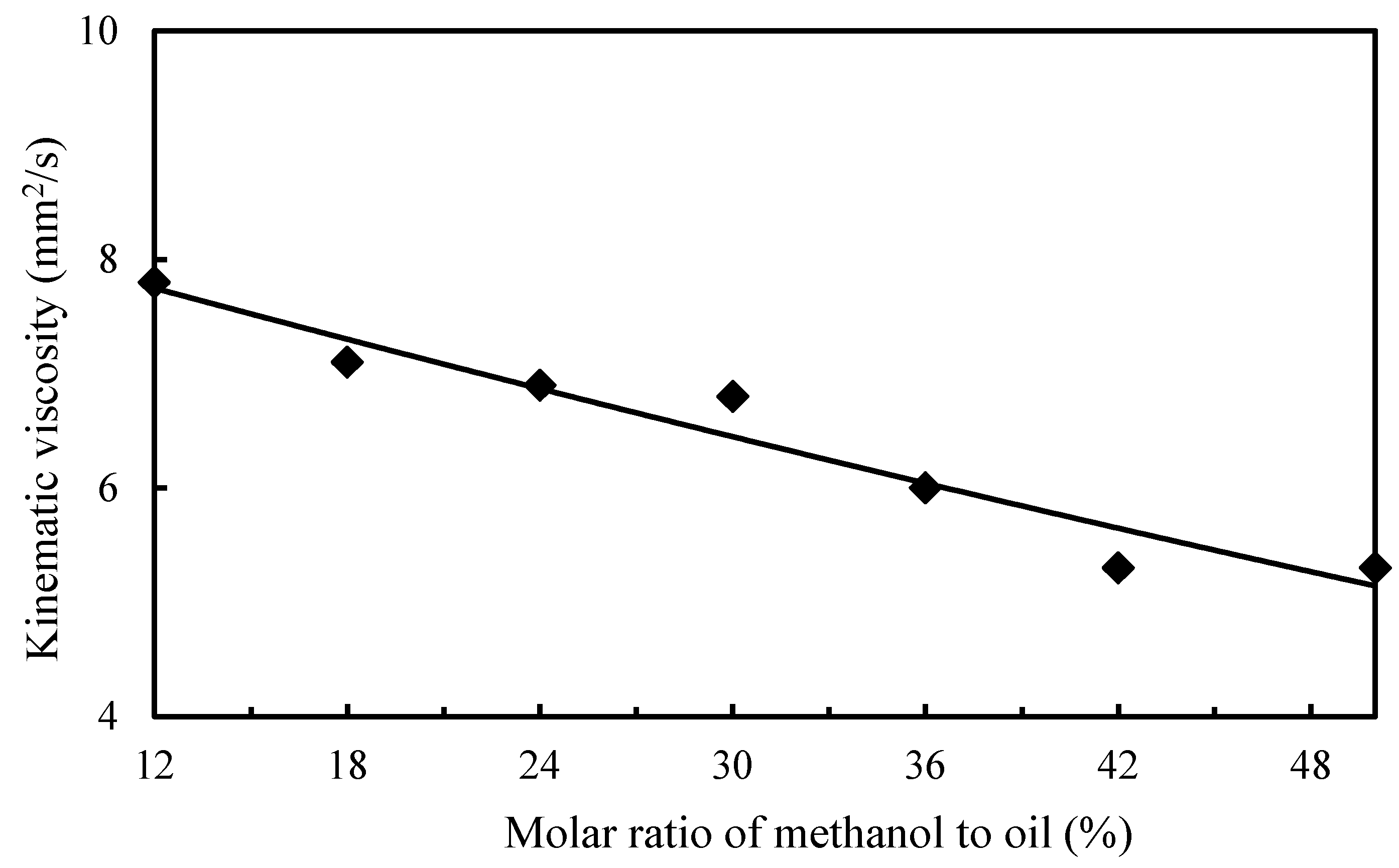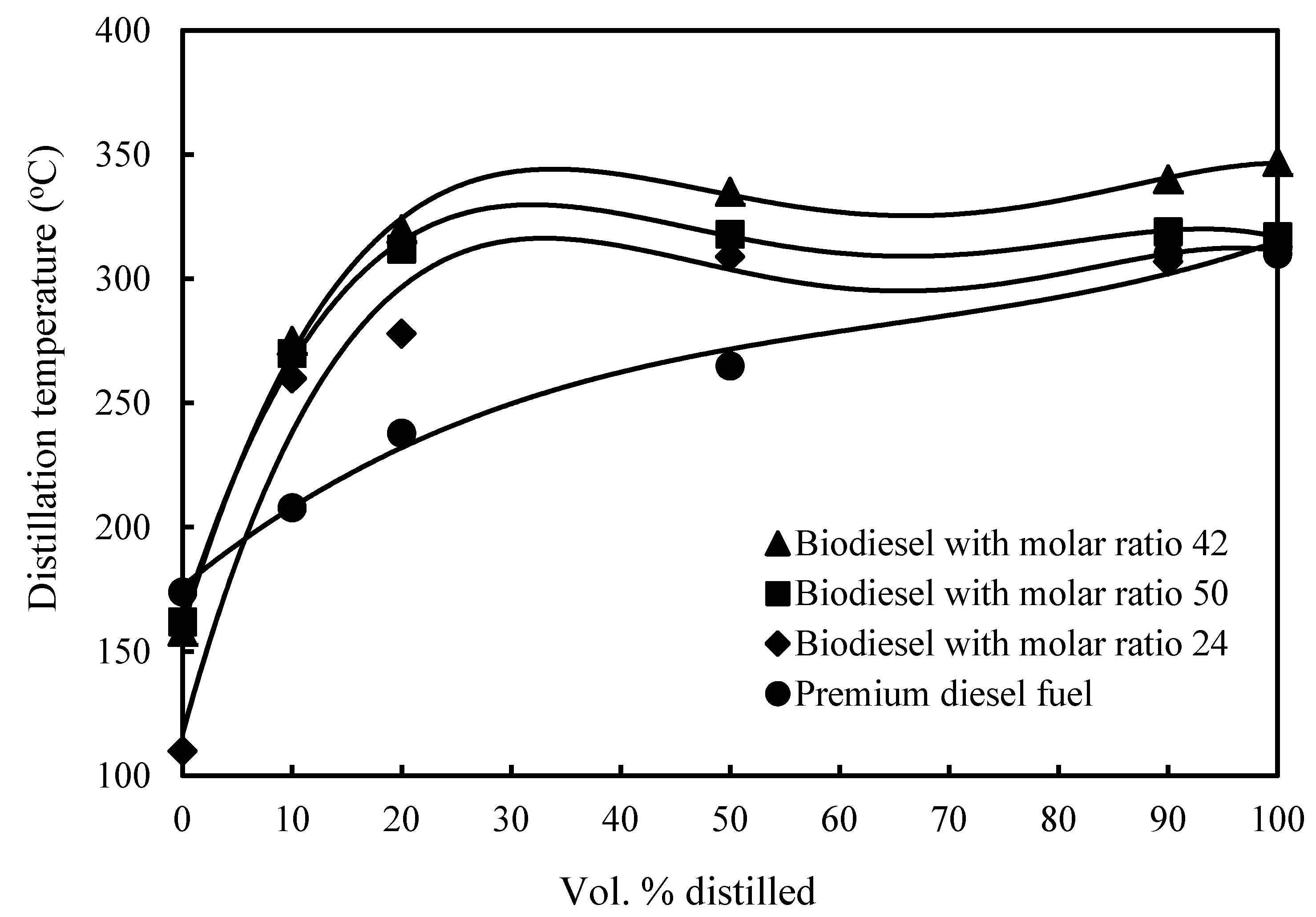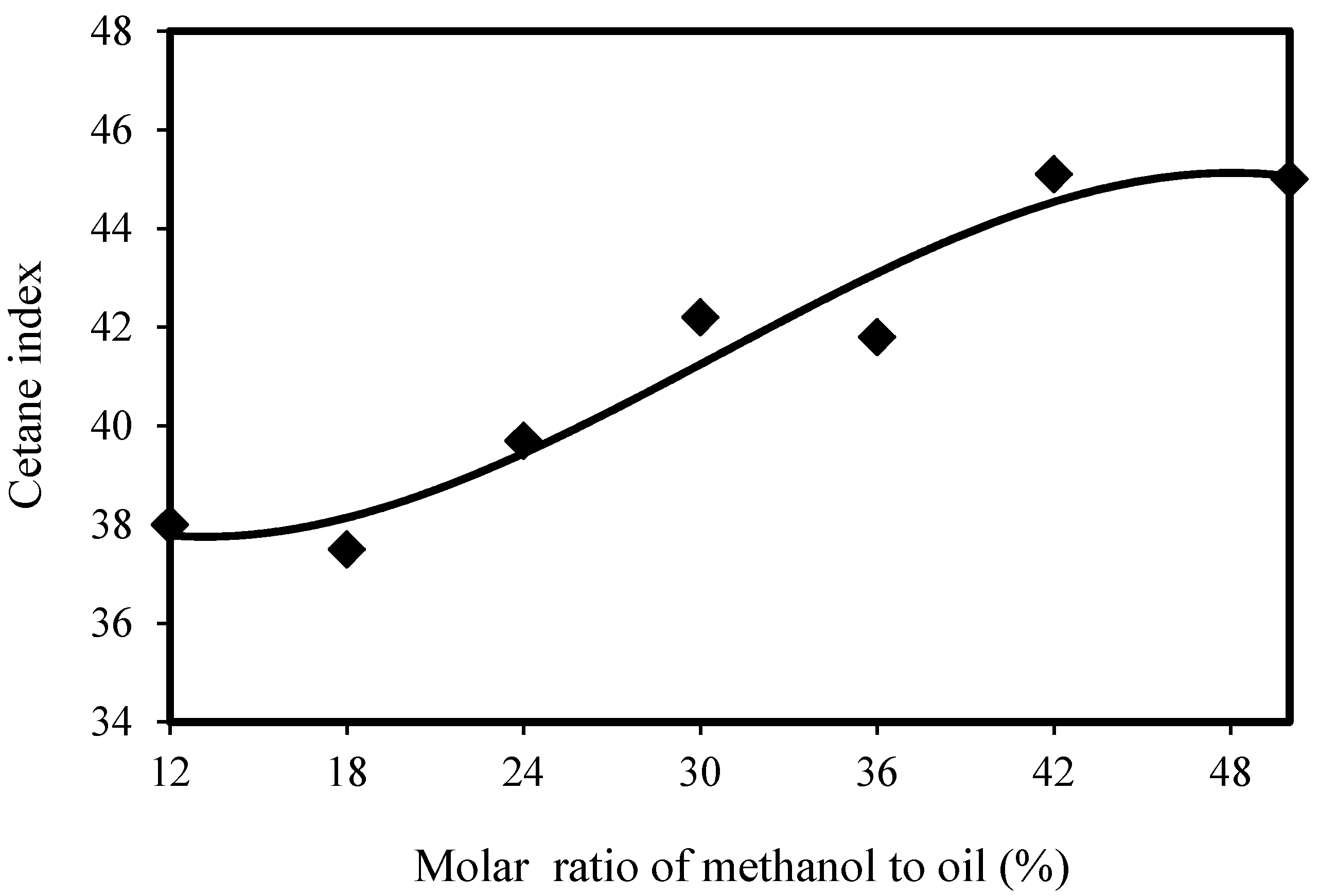Fuel Characteristics of Biodiesel Produced from a High-Acid Oil from Soybean Soapstock by Supercritical-Methanol Transesterification
Abstract
:1. Introduction
2. Experimental Details
2.1. Preparation of the Biodiesel

2.2. Analysis of the Fuel Properties of the Biodiesel
3. Results and Discussion
3.1. Fuel Characteristics of the High-acid Oil and Its Biodiesel Product
| Fuel property | Fuel type | |
|---|---|---|
| High-acid oil | Biodiesel product | |
| Heating value (MJ/kg) | 39.03 | 39.55 |
| Carbon residue (wt %) | 0.28 | 0.25 |
| Specific gravity | 0.912 | 0.884 |
| Water content (wt %) | 0.787 | 0.154 |
| Kinematic viscosity (mm2 s) | 35 | 5.2 |
| Flash point (°C) | -* | 118 |
| Acid value (mg KOH/g) | -* | 0.8 |
| Cetane index | -* | 45.49 |
| Iodine value (g I/100g oil) | -* | 62.6 |
3.2. Fatty Acid Composition
3.3. Kinematic Viscosity

| Type of fatty Acids | Biodiesel from high-acid oil with M/H = 24 | Biodiesel from high-acid oil with M/H = 42 | Biodiesel from waste cooking oil | High-acid oil |
|---|---|---|---|---|
| Palmitic acid (C16:0) | 23.45 | 22.21 | 22.99 | 12.79 |
| Palmitoleic acid (C16:1) | 0 | 0 | 1.316 | 0 |
| Stearic acid (C18:0) | 10.17 | 9.91 | 5.32 | 4.69 |
| Oleic acid (C18:1) | 36.75 | 38.91 | 36.64 | 24.77 |
| Linoleic acid (C18:2) | 26.49 | 25.38 | 29.24 | 50.01 |
| Linolenic acid (C18:3) | 1.94 | 2.82 | 3.11 | 7.23 |
| Behenic acid (C22:0) | 1.20 | 0.76 | 1.4 | 0.50 |
| Saturated fatty acids | 34.82 | 32.88 | 29.71 | 17.98 |
3.4. Water Content

3.5. Distillation Temperature

3.6. Cetane Index

4. Conclusions
- (1)
- Oleic acid (C18:1), linoleic acid (C18:2), and palmitic acid (C16:0) were the three main compounds found in the high-acid oil-biodiesel, whereas the raw high-acid oil was primarily composed of unsaturated fatty acids. The saturated fatty acid content of the high-acid oil-biodiesel was significantly increased.
- (2)
- The level of saturated fatty acids in the biodiesel produced from the high-acid oil by supercritical-methanol transesterification was higher than in the waste cooking oil-biodiesel produced by subcritical transesterification of a strong alkaline catalyst.
- (3)
- The fuel properties of the biodiesel produced by the supercritical-methanol transesterification system were much better than those of the raw high-acid oil, particularly the specific gravity, water content and kinematic viscosity.
- (4)
- An increase in the molar ratio of methanol to high-acid oil resulted in an increase in the kinematic viscosity, distillation temperature, and cetane index and a decrease in the specific gravity, kinematic viscosity, and water content of the high-acid oil-biodiesel.
Acknowledgements
References
- Liaquat, A.M.; Kalam, M.A.; Masjuki, H.H.; Jayed, M.H. Potential emission reduction in road transport sector using biofuel in developing countries. Atmos. Environ. 2010, 44, 3869–3877. [Google Scholar] [CrossRef]
- Lin, C.Y.; Huang, T.H. Cost–benefit evaluation of using biodiesel as an alternative fuel for fishing boats in Taiwan. Mar. Policy 2012, 36, 103–107. [Google Scholar] [CrossRef]
- Boey, P.L.; Ganesan, S.; Maniam, G.P.; Khairuddean, M.; Lim, S.L. A new catalyst system in transesterification of palm olein: Tolerance of water and free fatty acids. Energy Convers. Manag. 2012, 56, 46–52. [Google Scholar] [CrossRef]
- Anitescu, G.; Bruno, T.J. Fluid properties needed in supercritical transesterification of triglyceride feedstocks to biodiesel fuels for efficient and clean combustion—A review. J. Supercrit. Fluids 2012, 63, 133–149. [Google Scholar] [CrossRef]
- Haas, M.J.; Scott, K.M.; Alleman, T.L.; McCormick, R.L. Engine performance of biodiesel fuel prepared from soybean soapstock: A high quality renewable fuel produced from a waste feedstock. Energy Fuels 2001, 15, 1207–1212. [Google Scholar] [CrossRef]
- Park, J.Y.; Wang, Z.M.; Kim, D.K.; Lee, J.S. Effects of water on the esterification of free fatty acids by acid catalysts. Renew. Energy 2010, 35, 614–618. [Google Scholar] [CrossRef]
- Boer, K.; Bahri, P.A. Supercritical methanol for fatty acid methyl ester production: A review. Biomass Bioenergy 2011, 35, 983–991. [Google Scholar] [CrossRef]
- Haas, M. Improving the economics of biodiesel production through the use of low value lipids as feedstocks: Vegetable oil soapstock. Fuel Process. Technol. 2005, 86, 1087–1096. [Google Scholar] [CrossRef]
- Azócar, L.; Ciudad, G.; Heipieper, H.J.; Navia, R. Biotechnological processes for biodiesel production using alternative oils. Appl. Microbiol. Biotechnol. 2010, 88, 621–636. [Google Scholar] [CrossRef] [PubMed]
- Anitescu, G.; Deshpande, A.; Tavlarides, L.L. Integrated technology for supercritical biodiesel production and power cogeneration. Energy Fuels 2008, 22, 1391–1399. [Google Scholar] [CrossRef]
- Bunyakiat, K.; Makmee, S.; Sawangkeaw, R.; Ngamprasertsith, S. Continuous production of biodiesel via transesterification from vegetable oils in supercritical methanol. Energy Fuels 2006, 20, 812–817. [Google Scholar] [CrossRef]
- Operational Manual for the Supercritical-Methanol Reacting System; Jeoou Rong Industrial Corp.: Taipei, Taiwan, 2006.
- Operational Instruction Manual for the 1266 Isoperibol Bomb Calorimeter; Parr Instrument Company: Moline, IL, USA, 1988.
- Pulkrabek, W.W. Thermochemistry and Fuels. In Engineering Fundamentals of the Internal Combustion Engine, 2nd ed.; Pearson Prentice-Hall Inc.: Singapore, 2004; pp. 168–169. [Google Scholar]
- Lin, C.Y.; Chiu, C.C. Characteristics of palm-oil biodiesel under long-term storage conditions. Energy Convers Manag. 2010, 51, 1464–1467. [Google Scholar] [CrossRef]
- Hoekman, S.K.; Broch, A.; Robbins, C.; Ceniceros, E.; Natarajan, M. Review of biodiesel composition, properties, and specifications. Renew. Sust. Energy Rev. 2012, 16, 143–169. [Google Scholar] [CrossRef]
- Demirbas, A. Studies on cottonseed oil biodiesel prepared in non-catalytic SCF conditions. Bioresour. Technol. 2008, 99, 1125–1130. [Google Scholar] [CrossRef] [PubMed]
- Focke, W.W.; Westhuizen, I.; Grobler, A.B.L.; Nshoane, K.T.; Reddy, J.K.; Luyt, A.S. The effect of synthetic antioxidants on the oxidative stability of biodiesel. Fuel 2012, 94, 227–233. [Google Scholar] [CrossRef]
- Arisoy, K. Oxidative and thermal instability of biodiesel. Energy Source 2008, 30, 1516–1522. [Google Scholar] [CrossRef]
- Aktas, D.F.; Lee, J.S.; Little, B.J.; Ray, R.I.; Davidova, I.A.; Lyles, C.N.; Suflita, J.M. Anaerobic metabolism of biodiesel and its impact on metal corrosion. Energy Fuels 2010, 24, 2924–2928. [Google Scholar] [CrossRef]
- Lapuerta, M.; Rodrıguez-Fernandez, J.; Fermın Oliva, F.; Canoira, L. Biodiesel from low-grade animal fats: diesel engine performance and Emissions. Energy Fuels 2009, 23, 121–129. [Google Scholar] [CrossRef]
- Lin, C.Y.; Li, R.J. Fuel properties of biodiesel produced from the crude fish oil from the soapstock of marine fish. Fuel Process. Technol. 2009, 90, 130–136. [Google Scholar] [CrossRef]
- Knothe, G. Dependence of biodiesel fuel properties on the structure of fatty acid alkyl esters. Fuel Process. Technol. 2005, 86, 1056–1070. [Google Scholar] [CrossRef]
- Ramadhas, A.S.; Jayaraj, S.; Muraleedharan, C.; Padmakumari, K. Artificial neural networks used for the prediction of the cetane number of biodiesel. Renew. Energy 2006, 31, 2524–2533. [Google Scholar] [CrossRef]
© 2012 by the authors; licensee MDPI, Basel, Switzerland. This article is an open access article distributed under the terms and conditions of the Creative Commons Attribution license (http://creativecommons.org/licenses/by/3.0/).
Share and Cite
Lin, C.-Y.; Lin, Y.-W. Fuel Characteristics of Biodiesel Produced from a High-Acid Oil from Soybean Soapstock by Supercritical-Methanol Transesterification. Energies 2012, 5, 2370-2380. https://doi.org/10.3390/en5072370
Lin C-Y, Lin Y-W. Fuel Characteristics of Biodiesel Produced from a High-Acid Oil from Soybean Soapstock by Supercritical-Methanol Transesterification. Energies. 2012; 5(7):2370-2380. https://doi.org/10.3390/en5072370
Chicago/Turabian StyleLin, Cherng-Yuan, and Yi-Wei Lin. 2012. "Fuel Characteristics of Biodiesel Produced from a High-Acid Oil from Soybean Soapstock by Supercritical-Methanol Transesterification" Energies 5, no. 7: 2370-2380. https://doi.org/10.3390/en5072370
APA StyleLin, C.-Y., & Lin, Y.-W. (2012). Fuel Characteristics of Biodiesel Produced from a High-Acid Oil from Soybean Soapstock by Supercritical-Methanol Transesterification. Energies, 5(7), 2370-2380. https://doi.org/10.3390/en5072370





